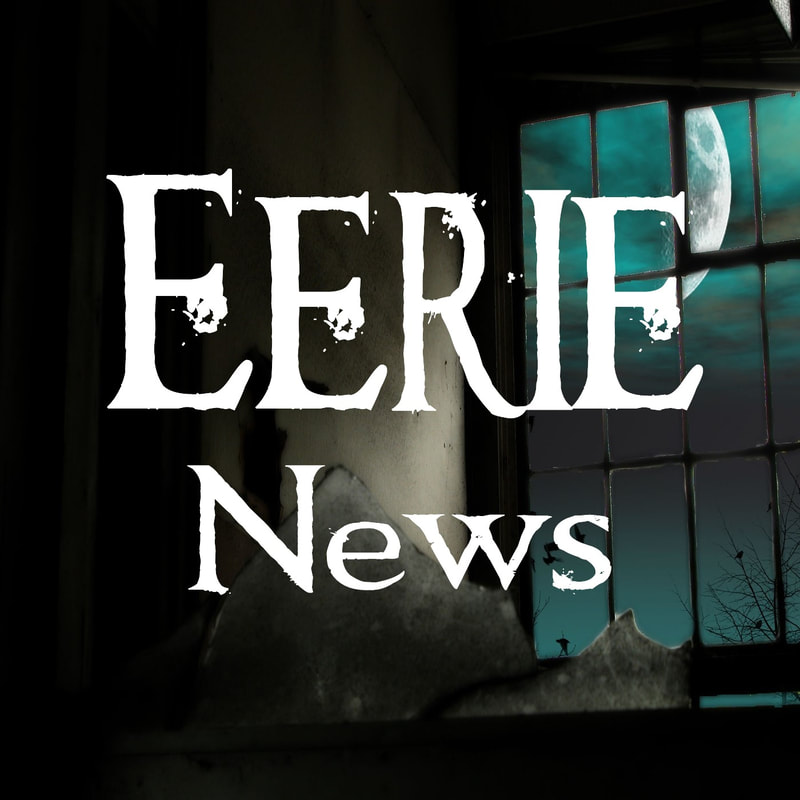 By M.P. Pellicer | Stranger Than Fiction Stories The place was Sandtown Road, once known as the Sand Town Trail, near the West End in Atlanta where a man's skeleton was found. It was a swampy area, some distance from the road in a dense area of cane growth. Most noted that it was an "admirable spot for a murder."  The discovery of an unknown man in 1897 was tied to the murder of Forest Crowley in 1894 The discovery of an unknown man in 1897 was tied to the murder of Forest Crowley in 1894 Atlanta, April 12, 1897 The bones were found by a policeman's young son, and soon crowds flocked to the place. All believed the person was a victim of murder, with the body not fully decomposed. He appeared to have been a man of means. Near to the remains was a piece of a gold chain, a small silver ring and a dainty gold locket, which was in the man's pocket, and not discovered by his attacker, if theft was the motive. However there were those that didn't believe he was killed due to a botched robbery, but that he was the accomplice of Will Myers in the murder of Forest Crowley three years before. If this skeleton was indeed Myers' accomplice then he might be the famous "Brown Allen" who Myers said was really the one who had killed Forest Crowley. The one thing though was that Myers could never explain was how this so-called accomplice disappeared without a trace after the crime. 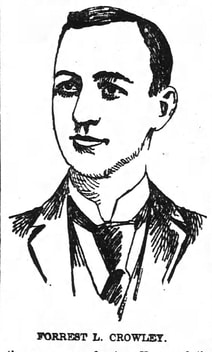 Illustration of Forest Crowley c.1894 Illustration of Forest Crowley c.1894 THE MURDER OF FOREST CROWLEY (Prequel, 3 years before) September 1894 Forest L. Crowley was found dead and mangled in Westwood Park, early in the morning of September 19, 1894. His father and friends had spent the night searching for him. He was lying face down with his head crushed. His clothes were torn and bloody, and there was evidence of a terrible struggle. An examination of Crowley's body at the undertaker found that besides being beaten over the head, he was shot in the back of the neck. The discharge was from a .32 caliber gun. The 28-year-old had disappeared the day before and was seen in the company of Will Myers, who coincidentally had disappeared as well. Crowley ran a general store and livery stable at Roswell. His father Seaborn Crowley was the president of a large woolen mill. The Crowley family was an old and wealthy one, with a high social and financial standing, however their wealth did not protect them from heartache. Only 18 months before, Seaborn Crowley had lost another son, 25-year-old William to suicide over the unrequited love affair with a young woman in Marietta. 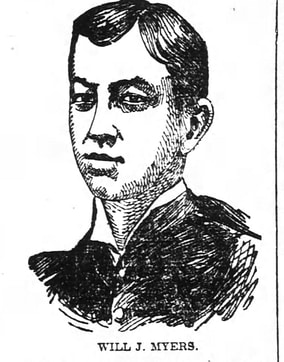 Will Myers c.1894 Will Myers c.1894 Seaborn Crowley described how the week before his son's murder, Myers had come to him for the sale of several mules, claiming he had a purchaser for the animals. Forest Crowley traveled to Atlanta to finalize the sale. Crowley and Myers set out in a buggy hired at Stewart & Browden's livery stable, and the rig was returned later in the morning by Myers who was alone. Seaborn Crowley came searching for his son, after he failed to keep an appointment. He ran into Myers twice on the streets, where each time he gave an evasive answer as to where his son was at. He last saw Myers take a hack towards the Union depot. Crowley was carrying $500 in a large red pocketbook, which was not found with the body. In another pocket he had $126, which the murderer overlooked. Will Myers, 19, was well known in Atlanta. He was the son of a Broad Street barber, and surprisingly thought of as an honest young man. He lived with his father, Benjamin P. Myers at 60 Alexander Street. Mr. Myers before working at the barber shop, was the proprietor of the Crescent Steam Laundry, and before that he was a member of the Pinkerton detective force in Cincinnati. 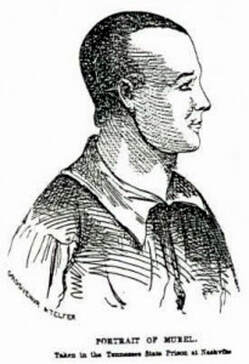 The only known, accurate portrait, of John Murrell, made during his lifetime when he was in the Tennessee State Pen. The only known, accurate portrait, of John Murrell, made during his lifetime when he was in the Tennessee State Pen. It was suspected Will Myers fled to Cincinnati, and the city was notified to watch for him. The suspicions were well founded when he was apprehended after a barber recognized him, and called the police. At the trial, he named Brown Allen as an accomplice, however police thought the character was mythical, and he had adopted the name from the Brown & Allen drug store on Whitehall Street. In November 1894, Myers was found guilty of murder without a recommendation. He was sentenced to be hung on February 8, 1895, but because of certain remarks made by a juror, the supreme court sent the case back. It was set several times and finally in July 1895 he was found guilty again, and sentenced to death by hanging to be carried out on August 2nd. Strangely it was circulated during the trial that Myers had modeled the plan of robbing and killing Crowley based on an old book titled: The Life and Adventures of John A. Murrell, the Great Southern and Western Land Pirate (1847). Murrell (1806-1844) was a true life figure that during the 1820 and 30s was known as a highwayman, killer, horse thief and counterfeiter. His first criminal conviction was for stealing a horse as a teenager, where he was branded on the base of his thumb with an "HT" for horse thief. He was also flogged and sentenced to six years in prison. After his release he continued to plunder and kill in the South. Eventually Murrell was caught and convicted in Tennessee. He was released in 1844 after spending 10 years in prison. His freedom was short-lived when he died 9 months later from tuberculosis. His body was dug up from his grave in the Smyrna First United Methodist Church Cemetery. Parts of him were stolen by grave robbers, and what was left behind was half-eaten by feral hogs. The head was taken, pickled and displayed at county fairs, but it eventually went missing. The Tennessee State Museum has one of his thumbs. In 1883, Mark Twain--Life on the Mississippi, made the following comment on Murrell: What are [Jesse] James and his half dozen vulgar rascals compared with this stately old time criminal, with his sermons, his meditated insurrections and city captures, and his majestic following of ten hundred men, sword to do his evil will! 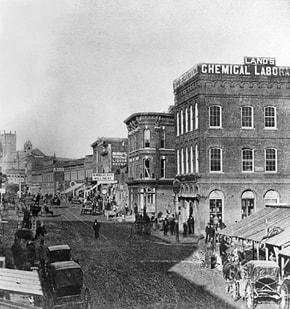 Peachtree St. Atlanta c,1875 Peachtree St. Atlanta c,1875 There were many things within the book which indicated Myers studied and planned the crime based on the contents. He even used the aliases used by Murrell. In one instance, Murrell enticed a Louisiana planter to another town with the idea of completing a sale and then killing him, identical to the murder of Crowley. Murrell masqueraded under the name of C. Morlein. Myers used the name C.D. Morlein, Jr. at the Folsom Hotel where he stayed, and at a pawn shop. The red wallet carried by Crowley was found in the hotel room. When Murrell fled New Orleans he used the name of J.C. Cunningham; when Myers left Atlanta he registered at a Cincinnati hotel with the exact same name. Of several murders and robberies described in the book, there was one in particular that shaped the killing of Crowley. It described where the bandit and one of his men had crossed over into Tennessee, leaving devastation and death in their wake. It read like this: In crossing the Cumberland mountains, Murrell and his companion fell in with a young South Carolinian trader named Woods, who had been to Tennessee to buy hogs and mules, but who, having found the animals to much advanced in price had declined to purchase and was returning home with all his money in his pocket. These facts were soon ascertained by Murrell in a conversation started for the purpose. Then he decided that he should make himself master of the gold. There was but one safe way to accomplish this, and that was by death. 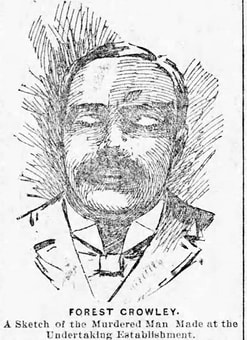 Sketch made of Forest Crowley at the undertakers c.1894 Sketch made of Forest Crowley at the undertakers c.1894 Will Myers escaped the hangman's noose when he escaped in the autumn of 1894. It was remarked that it appeared as if the earth had swallowed him, despite the city being scoured in order to apprehend him. A $500 reward was offered for his capture. In March 1898, Walter Goza a trusty in the jail office was arrested on a charge of conspiracy. It was claimed that he gave Will Myers the pistol he was said to have used when he leaped through the jail door. Many suspected that Myers' father had also aided in his escape, but he denied it emphatically. In 1909, a newspaper received a letter from a man who claimed he was Will Myers, and that he served under Captain Wilcox in the Spanish-American war. He was asking for a pardon from the governor. He related in the letter that he was living under an assumed name, had married and had three children. No pardon was offered, and the story disappeared. Will Myers was never found, and escaped the consequences of murdering Forest Crowley. It's unknown if he killed others, lived into old age or if justice found him in some other way. Just as mysterious is the name of the man found dead in the canebrake in 1897. Certain clues point to the conclusion that his death was the handiwork of Myers as well. The scene was but a short distance away from where Crowley's body was found. During Myers' trial the mud on his trousers matched the exact shade of the mire in the canebrake, where the mystery man was found. The theory, which he was never prosecuted for, was that Myers after killing Forest Crowley, turned on his helper and did away with him in order to assure his silence, allowing him to keep all the money. Source - The Atlanta Journal, The Atlanta Constitution
0 Comments
Your comment will be posted after it is approved.
Leave a Reply. |
Stranger Than Fiction StoriesM.P. PellicerAuthor, Narrator and Producer Archives
July 2024
Categories
All
|
Stories of the Supernatural
- Stories of the Supernatural
- Miami Ghost Chronicles
- M.P. Pellicer | Author
- Stranger Than Fiction Stories
- Eerie News
- Supernatural Storytime
-
Astrology Today
- Tarot
- Horoscope
- Zodiac
-
Haunted Places
- Animal Hauntings
- Belleview Biltmore Hotel
- Bobby Mackey's Honky Tonk
- Brookdale Lodge
- Chacachacare Island
- Coral Castle
- Drayton Hall Plantation
- Jonathan Dickinson State Park
- Kreischer Mansion
- Miami Biltmore Hotel
- Miami Forgotten Properties
- Myrtles Plantation
- Pinewood Cemetery
- Rolling Hills Asylum
- St. Ann's Retreat
- Stranahan Cromartie House
- The Devil Tree
- Trans-Allegheny Lunatic Asylum
- West Virginia Penitentiary
- Paranormal Podcasts
"When misguided public opinion honors what is despicable and despises what is honorable, punishes virtue and rewards vice, encourages what is harmful and discourages what is useful, applauds falsehood and smothers truth under indifference or insult, a nation turns its back on progress and can be restored only by the terrible lessons of catastrophe."
- Frederic Bastiat
- Frederic Bastiat

Copyright © 2009-2024 Eleventh Hour LLC. All Rights Reserved ®
DISCLAIMER
DISCLAIMER
 RSS Feed
RSS Feed





